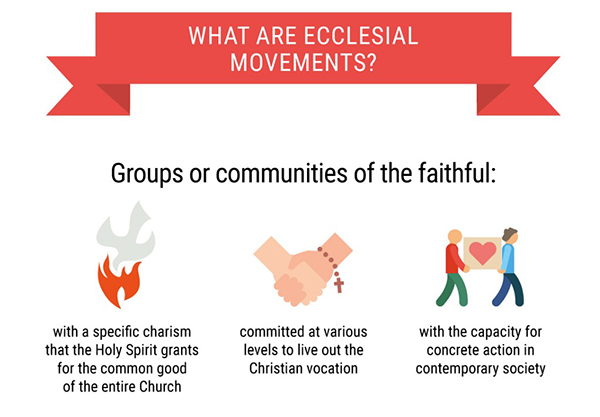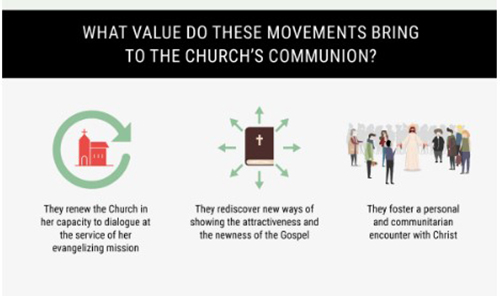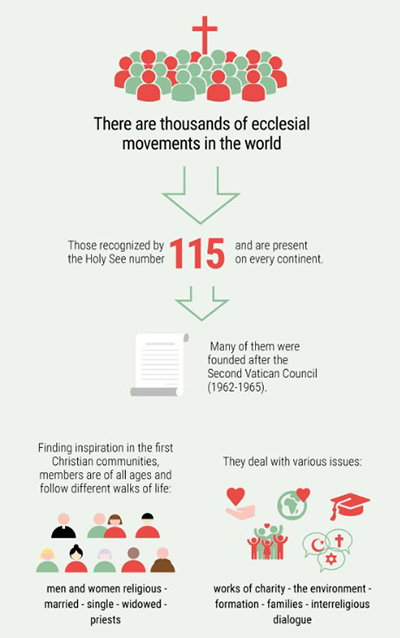By Archdiocese of Miami -
VATICAN CITY | In this month's prayer intention, Pope Francis invites ecclesial groups to “place their own charisms at the service of the world’s needs,” avoiding any “temptation to close in on themselves.”
Ecclesial movements “are a treasure in the Church”: they speak “different languages” and “they seem different, but it is their creativity that creates these differences.”
This is how Pope Francis begins The Pope Video for May, in which he shares his new prayer intention entrusted to everyone in the Catholic Church through the Pope’s Worldwide Prayer Network. In fact, the Holy Father’s reflection this month is dedicated to ecclesial movements and groups which “renew the Church with their capacity for dialogue at the service of her evangelizing mission.”
At the service of the Church’s evangelizing mission
Ecclesial movements are groups of people committed to an apostolate with their own specific charism, which the Holy Spirit grants for the common good of the Church. Composed mainly of members of the lay faithful, the search for a personal encounter with Christ unites them. At the same time, at the service of the Gospel, they dialogue with today’s women and men, wherever they are.
These ecclesial movements and groups find “new ways of showing the attractiveness and the newness of the Gospel,” Pope Francis explains in The Pope Video. They renew the Church through languages that “seem different,” and with the “creativity” of each charism.
As Pope Saint John Paul II also said: “Each movement differs from the others, but all are united in the same communion and for the same mission,” without forgetting that “true charisms cannot but tend toward an encounter with Christ.”
Many charisms, one mission
The Pope Video – produced in collaboration with the Dicastery for Laity, Family and Life, which counts among its tasks that of accompanying the foundation and development of associations of the laity and ecclesial movements – narrates pieces of their lives in very different contexts.
There are, for example, Portuguese scouts on pilgrimage with the World Youth Day cross; members of the Neocatechumenal Way engaged in evangelization on the streets of American cities; Shalom missionaries in Madagascar and Communion and Liberation missionaries in the Philippines; members of Nuovi Orizzonti (New Horizons), together with families from Brazilian favelas; and members of the Pope John XXIII Community with families in Kenyan slums; members of Sant’Egidio welcoming refugees from Libya arriving through humanitarian corridors; members of the Focolare Movement cleaning polluted beaches in Southeast Asia; young people from the Eucharistic Youth Movement in adoration in front of the Eucharist during its international congress.
Many different charisms, one sole mission: proclaiming the Gospel to different places and in different ways.
International, intergenerational, multi-vocational
“Ecclesial movements,” says Linda Ghisoni, under-secretary for the Dicastery for Laity, Family and Life, “are a huge gift for the Church in today’s societies. They are, in fact, bearers of a creativity that is continually renewed in order to bear witness to Jesus Christ and to the Good News of the Gospel to the men and women of today in the most diverse circumstances, and in very concrete ways. They are international, intergenerational, multi-vocational entities, with a proven formative potential, and they are called to not close in on themselves, but to live their authentic ecclesial vocation and mission.”
In harmony with the Church
The need to remain “in harmony with the Church” is precisely another aspect that Pope Francis highlights in this month’s video. In fact, in a paternal tone, the pope invites movements to always work at the service of the bishops and parishes.
“The danger,” he reminds them, is the “temptation to close in” on themselves. Each movement, in fact, is not an end in itself, but a place that fosters an encounter with God which finds its fulfilment by “placing their own charisms at the service of the world’s needs.”




